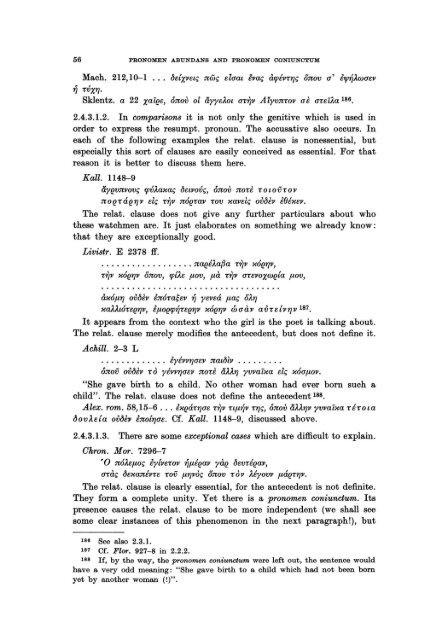Pronomen Abundans and Pronomen Coniunctum. A ... - DWC
Pronomen Abundans and Pronomen Coniunctum. A ... - DWC
Pronomen Abundans and Pronomen Coniunctum. A ... - DWC
Create successful ePaper yourself
Turn your PDF publications into a flip-book with our unique Google optimized e-Paper software.
56 PRONOMEN ABUNDANS AND PRONOMEN CONIUNCTUM<br />
Mach. 212,10-1 ... (JetXVetç nwç ÛCTat lvaç àfl'év'r1Jç önov CT' lvn1ÄwCTev<br />
1] 'rVxr;.<br />
Sklentz. a 22 xai(!e, ónov ol äyyeÄot CT'riJV Alyvn'rov CTF- CTuïÄa 186.<br />
2.4.3.1.2. In comparis0n8 it is not only the genitive which is used in<br />
order to express the resumpt. pronoun. The accusative also occurs. In<br />
each of the following examples the relat. clause is nonessential, but<br />
especially this sort of clauses are easily conceived as essential. For that<br />
reason it is better to discuss them here.<br />
Kall. 1148-9<br />
äy(!vnvovç ~Äa"aç (Jewovç, ónov no-rè 'rotoihov<br />
nO(!'rá(!1Jv elç 'riJv nÓ(!'rav 'rov "aveLç ov(JF-V lOé"ev.<br />
The relat. clause does not give any further particulars about who<br />
these watchmen are. It just elaborates on something we already know:<br />
that they are exceptionally good.<br />
Livistr. E 2378 ff.<br />
I~ fJ ' I<br />
• . . . . . . . . . . . . . . . . . na(!Ella a 'r1]v "O(!1JV,<br />
'riJv "Ó(!1JV önov, fl'tÄe p,ov, p,à 'r~v CTUVOXW(!ta p,ov,<br />
à"óp,1J oV(JF-V lnó-ra;ev 1] yeveá p,aç öÄ1J<br />
"a).ÄtÓU(!1JV, lp,o(!fl'1}u(!1Jv "Ó(!1JV wCTàv avutv1Jv 187.<br />
It appears from the context who the girl is the poet is talking about.<br />
The relat. clause merely modifies the antecedent, but does not define it.<br />
Achill. 2-3 L<br />
· . . . . . . . . . . . . lyévv1JCTeV nat(Jlv ........ .<br />
ónov oV(JF-V 'rà yéVV1JCTEV no-rè äÄÄ1J yvvaï"a elç "ÓCTp,OV.<br />
"She gave birth to a child. No other woman had ever bom such a<br />
child". The relat. clause does not define the antecedent1 88 •<br />
Alex. rom. 58,15-6 ... l,,(!á'r1JCTE 'riJv 7:tp,1}v 'r1Jç, ónov äÄÄ1Jv yvvaï"a d'rota<br />
(JovÄeta ov(JF-V lnot1JCTE. Cf. Kall. 1148-9, discussed above.<br />
2.4.3.1.3. There are some exceptional cases which are difficult to explain.<br />
Ohron. Mor. 7296-7<br />
• 0 nóÄEp,oç lytVE'rOV 1]p,é(!av yà(! (Jevd(!av,<br />
CT'ràç (Je"anévu 'roV p,1Jvàç önov 'r à v Äéyovv p,á(!'r1Jv.<br />
The relat. clause is clearly essential, for the antecedent is not definite.<br />
They form a complete unity. Yet there is a pronomen coniunctum. lts<br />
presence causes the relat. clause to be more independent (we shall see<br />
some clear instances of this phenomenon in the next paragraph!), but<br />
186 See a1so 2.3.1.<br />
187 Cf. Flor. 927-8 in 2.2.2.<br />
188 If, by the way, the pronomen coniunctum were 1eft out, the sentence would<br />
have a very odd meaning : "She gave birth to a child which had not been born<br />
yet by another woman (!)".
















